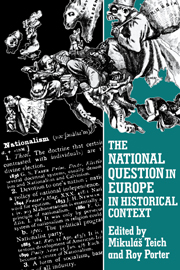Book contents
- Frontmatter
- Contents
- List of maps
- Notes on contributors
- Acknowledgements
- Introduction
- 1 The British Isles: Celt and Saxon
- 2 The making of the French nation
- 3 The national question in Italy
- 4 The roots of the national question in Spain
- 5 Shifting nationalism: Belgians, Flemings and Walloons
- 6 The nation in German history
- 7 Nationalism and nation-state in Germany
- 8 The national identity of the Austrians
- 9 The Czechs
- 10 The national question in Hungary
- 11 The union of Dalmatia with northern Croatia: a crucial question of the Croatian national integration in the nineteenth century
- 12 The national question in Poland in the twentieth century
- 13 Finland: from Napoleonic legacy to Nordic co-operation
- Index
2 - The making of the French nation
Published online by Cambridge University Press: 30 November 2009
- Frontmatter
- Contents
- List of maps
- Notes on contributors
- Acknowledgements
- Introduction
- 1 The British Isles: Celt and Saxon
- 2 The making of the French nation
- 3 The national question in Italy
- 4 The roots of the national question in Spain
- 5 Shifting nationalism: Belgians, Flemings and Walloons
- 6 The nation in German history
- 7 Nationalism and nation-state in Germany
- 8 The national identity of the Austrians
- 9 The Czechs
- 10 The national question in Hungary
- 11 The union of Dalmatia with northern Croatia: a crucial question of the Croatian national integration in the nineteenth century
- 12 The national question in Poland in the twentieth century
- 13 Finland: from Napoleonic legacy to Nordic co-operation
- Index
Summary
INTRODUCTION
When was the French nation born? This has for long been a subject of discussion and controversy. Auguste Longnon, who taught at the Collège de France at the end of the nineteenth century, and who specifically wrote on the formation of French unity, claimed that it was ‘une merveilleuse histoire’. He saw what is now the familiar visage of France, of which the contours seem to have been sketched out in advance of the achievement of unity, as the result of a long series of obstinate and determined struggles. Longnon was lecturing well after the war of 1870, when France had been defeated by Germany, when Alsace and Lorraine had been annexed and when many writers, including historians, had written about France's past in order to encourage ‘a holy passion’ for la patrie and to discover a longstanding tradition of patriotic poetry and writing. Such historians invariably looked to a political date as one that could be seen to mark the beginning of the French nation. Clovis was the king of a Frankish tribe who defeated a Roman general in 486 and established his royal residence in Paris, thereby representing the transition from a minor barbarian king to the claimant of an imperial ruler, whose authority was accepted by what remained of the Roman Empire.
- Type
- Chapter
- Information
- The National Question in Europe in Historical Context , pp. 35 - 62Publisher: Cambridge University PressPrint publication year: 1993
- 3
- Cited by

